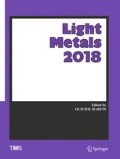Abstract
An investigative study was carried out to understand the effect of homogenization, hot and cold rolling as well as annealing cycle on improvement of deep drawing and anodizing quality of thin AA3003-O sheets. Poor drawability of the sheets was attributed to a coarse average grain size, high cube texture intensity and low average normal anisotropy (\( \overline{R} \)). Amount of Al–TiB grain refiner was increased in the casting stage, leading to a significant reduction in as-cast grain size. The 2-stage homogenization cycle was optimized to maximize the conversion of β-phase (Al6(Mn,Fe)) to α-phase (Al(Mn,Fe)Si), their number density, the area fractions of the precipitates and the electrical conductivity. The degree of hot rolling was increased to reduce the cube texture intensity in annealed circles. The annealing cycle was optimized to obtain the best combination of grain size, mechanical properties (UTS and total elongation), \( \overline{R} \) and average planar anisotropy, ΔR. AA3003-O circles successfully passed the deep drawing test without any tearing or deformation, up to a draw ratio of 2. Also the presence of the α-phase led to an improvement in the anodizing quality of the final product.
Access this chapter
Tax calculation will be finalised at checkout
Purchases are for personal use only
References
Analysis of optimization of blank holding force in deep drawing by using LS DYNA. Ramesh, G and Reddy, GCM. 4, 2013, International Journal Of Engineering Research and Applications (IJERA), Vol. 3, pp. 1975–1995.
Testing and modelling of material behaviour and formability in sheet metal forming. Bruschi, S, et al. 2014, CIRP Annals - Manufacturing Technology, Vol. 63, pp. 727–749.
Sheet Metal Forming: A Review. Hosford, WF and Duncan, JL. 1999, Journal of Metals, Vol. 51, pp. 39–44.
Evaluation of Workability. [book auth.] SL Semiatin. Dieter, GE. ASM Handbook Vol 14. s.l.: ASM International, 1993.
Experimental and analytical studies on the formability of 3.15 mm thick hot rolled low carbon steel and three 1 mm thick cold rolled aluminium alloy sheets, Date, PP. IIT Madras, India. 1991.
Strain hardening and formability. Mike, G. Materion Brush Performance alloys - Technical Tidbits. March 2013, 51.
Drawability and formability of sheet metals. Chandramouli, R. Mechanical Engineering, SASTRA University. pp. 1–8.
Development of an aluminum sheet alloy with improved formability. Sachdev, AK. 1988, Metallurgical transactions A, Vol. 21A, pp. 165–176.
Author information
Authors and Affiliations
Corresponding author
Editor information
Editors and Affiliations
Rights and permissions
Copyright information
© 2018 The Minerals, Metals & Materials Society
About this paper
Cite this paper
Giri, A., Adhikari, S., Saxena, M., Gupta, S., Jain, S. (2018). Deep Drawing and Anodizing Quality Improvement in AA3003-O Alloy by Optimization of Homogenization, Rolling and Annealing. In: Martin, O. (eds) Light Metals 2018. TMS 2018. The Minerals, Metals & Materials Series. Springer, Cham. https://doi.org/10.1007/978-3-319-72284-9_45
Download citation
DOI: https://doi.org/10.1007/978-3-319-72284-9_45
Published:
Publisher Name: Springer, Cham
Print ISBN: 978-3-319-72283-2
Online ISBN: 978-3-319-72284-9
eBook Packages: Chemistry and Materials ScienceChemistry and Material Science (R0)

